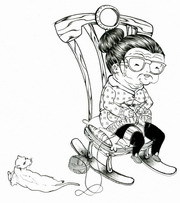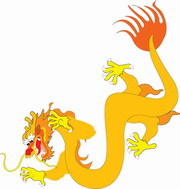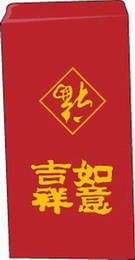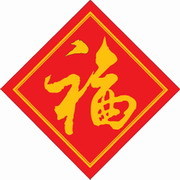Monsters, Firecrackers & Red Envelopes
 Almost everyone has heard about Spring Festival, or Chinese New Year (chunjie), the most important holiday in China. Traditionally, festivities begin on layue 24 (the 24th day of the twelfth lunar month), and finish on zhengyue 15 (the 15th day of the first lunar month), and preparations for this celebration begin several days or even weeks in advance. The festival dates back over 4,000 years, and Chinese people still follow traditions passed down through the generations, though most of the present-day customs have been simplified. Here are some examples of a few practices that have survived and are still widely celebrated in China.
Almost everyone has heard about Spring Festival, or Chinese New Year (chunjie), the most important holiday in China. Traditionally, festivities begin on layue 24 (the 24th day of the twelfth lunar month), and finish on zhengyue 15 (the 15th day of the first lunar month), and preparations for this celebration begin several days or even weeks in advance. The festival dates back over 4,000 years, and Chinese people still follow traditions passed down through the generations, though most of the present-day customs have been simplified. Here are some examples of a few practices that have survived and are still widely celebrated in China.
New Year’s Eve Vigil
 The Chinese refer to the last day of the year in the lunar calendar as chuxi. Chu means ‘to remove’ or ‘to eradicate,’ while xi means ‘evening’ or ‘night,’ and therefore the term chuxi signifies a moment of the year when people hope to get rid of any bad luck from the previous year and welcome in new fortune.
The Chinese refer to the last day of the year in the lunar calendar as chuxi. Chu means ‘to remove’ or ‘to eradicate,’ while xi means ‘evening’ or ‘night,’ and therefore the term chuxi signifies a moment of the year when people hope to get rid of any bad luck from the previous year and welcome in new fortune.
On the night of chuxi, Chinese people try to stay awake all night. This was not because they are too excited to sleep; rather, this custom follows the ancient Chinese tale that a ferocious monster called Nian was said to appear from the sea every chuxi to eat human beings. So on this night, people closed their doors early and stayed up all night waiting for the monster to leave. One year, the creature suddenly turned up in a village in southern China and ate everyone. The only survivors were a couple who had dressed in red and hung a red curtain on their door and a group of children who had been playing with firecrackers. People concluded that the monster was afraid of the color red as well as the noise of firecrackers or similar sounds, and it became a tradition to mark chuxi and New Year’s Day by dressing in red, decorating houses with red paper cuttings, raising red lanterns, playing drums and bells and setting off firecrackers.
Spring Festival Money
 Every Spring Festival, children all over China can expect to be given special pocket money wrapped in red paper. The amount will generally be much higher than their normal allowance and will come not only from their parents but from any relatives or friends of an older generation.
Every Spring Festival, children all over China can expect to be given special pocket money wrapped in red paper. The amount will generally be much higher than their normal allowance and will come not only from their parents but from any relatives or friends of an older generation.
This tradition goes back to ancient China, when a small devil called Sui , who had a white face and black hands, would haunt children during the last night of the year. One couple started putting a red paper bag filled with eight copper coins under their child’s pillow. In the past, copper coins were engraved with various lucky symbols and wishes such as ‘long life’ and ‘happiness,’ and people believed they had some special magic that warded off evil. When Sui got close to the child, it was scared away by the glowing light under the child’s pillow. This story spread across the country, and soon all parents were putting coins under their children’s pillows on the last night of the year.
The meaning behind this custom gradually changed. Nowadays money is given to bless children and bestow luck upon them. Ya means ‘to press,’ while the name of the devil has been replaced by a homophone – sui – which simply means ‘year.’ Qian means ‘money,’ and while yasui qian is no longer comprised of copper coins or left under pillows, they are still given to children wrapped in red paper, otherwise known as hongbao or ‘red envelopes.’
Fortunate Families
 Scrolls, door illustrations and paper cuttings are typical decorations found around the house during Spring Festival. Chinese people will paste special ‘Spring Festival’ scrolls on doors, put up paper cuttings on windowpanes and illustrations of mythical door guardians to protect themselves and their loved ones from evil. Don’t be scared by these mythical characters’ faces, as they are supposed to appear savage enough to defend a family against all evil and are always ready – weapon in hand – to fight for the household.
Scrolls, door illustrations and paper cuttings are typical decorations found around the house during Spring Festival. Chinese people will paste special ‘Spring Festival’ scrolls on doors, put up paper cuttings on windowpanes and illustrations of mythical door guardians to protect themselves and their loved ones from evil. Don’t be scared by these mythical characters’ faces, as they are supposed to appear savage enough to defend a family against all evil and are always ready – weapon in hand – to fight for the household.
In many households, the character for fu, meaning ‘fortune,’ is purposely hung upside-down on a wall or door. Some say this practice began during the Ming dynasty, when Emperor Zhu Yuanzhang tried to use the fu character as a secret sign for his soldiers: to pinpoint the people he wanted killed before sunrise on a certain day. In order to prevent this bloodbath, his wife, Empress Ma, secretly ordered every family in the city to paste a fu on their door. Later, when Zhu dispatched his assassins they were unable to distinguish their targets from the general population. One unfortunate family had been careless enough to place their fu upside-down accidentally. The soldiers noticed this and when they reported back to Zhu, told him about the house. In a rage, he ordered the killing of this family in place of his original targets.
To try and save the family, Ma reasoned with her husband, saying, “My dear Emperor, they knew you would visit them, and that is why they pasted the fu upside-down, because the upside-down fu just means their fortune is coming.” Indeed, daole, which means ‘upside down,’ shares the same sound as daole, meaning ‘to arrive,’ and thus the upside down Fu can therefore be interpreted as meaning ‘fortune is arriving.’ Ma’s reassuring words calmed the emperor, and Zhu removed the death sentence placed on that family, as well as his earlier targets.
Although this story has not been proven to be historically accurate, Chinese people still like to paste the Fu character upside-down on their doors every Spring Festival to show their respect to the warmhearted Empress Ma and promote good fortune.
Spring Festival Food
To many outsiders, it seems that every Chinese festival revolves around eating and drinking, and Spring Festival is no exception.
Dumplings are the most important food during Spring Festival. On Chinese New Year, it doesn’t matter where you are in the world – if you are Chinese, you will try your best to reunite with your family to cook and eat dumplings. This very special tradition is known as tuanyuan fan or a ‘family reuniting dinner.’
Another important dish during Spring Festival is tangyuan which are boiled glutinous rice balls served with soup. Normally made with a variety of sweet stuffings such as haw or black sesame, tangyuan are traditionally eaten on shiwu wan (or ‘fifteenth night’), the last day of Spring Festival, otherwise known as the Lantern Festival.
Pickled meats are also important for this celebration and must be prepared one month in advance so that the sauces have adequate time to penetrate into the meat. The meats also must be given time to dry. This dish is considered a necessity for Spring Festival banquets.
Dough-based snacks include rice cakes called niangao, literally translated as ‘annual cake,’ and zaohua mo , a type of bread shaped like a flower and sprinkled with dates. Both come in different flavors depending on what part of the country you are in. Beijingers generally prefer rice cakes made with sticky rice and millet, while people further north like them fried and often add red bean paste. Southern people often like to flavor their rice cakes with rose, sweet osmanthus and mint; in other areas, they will stuff a coin into the dough – whoever eats the rice cake with a coin inside will get good luck in the New Year.



